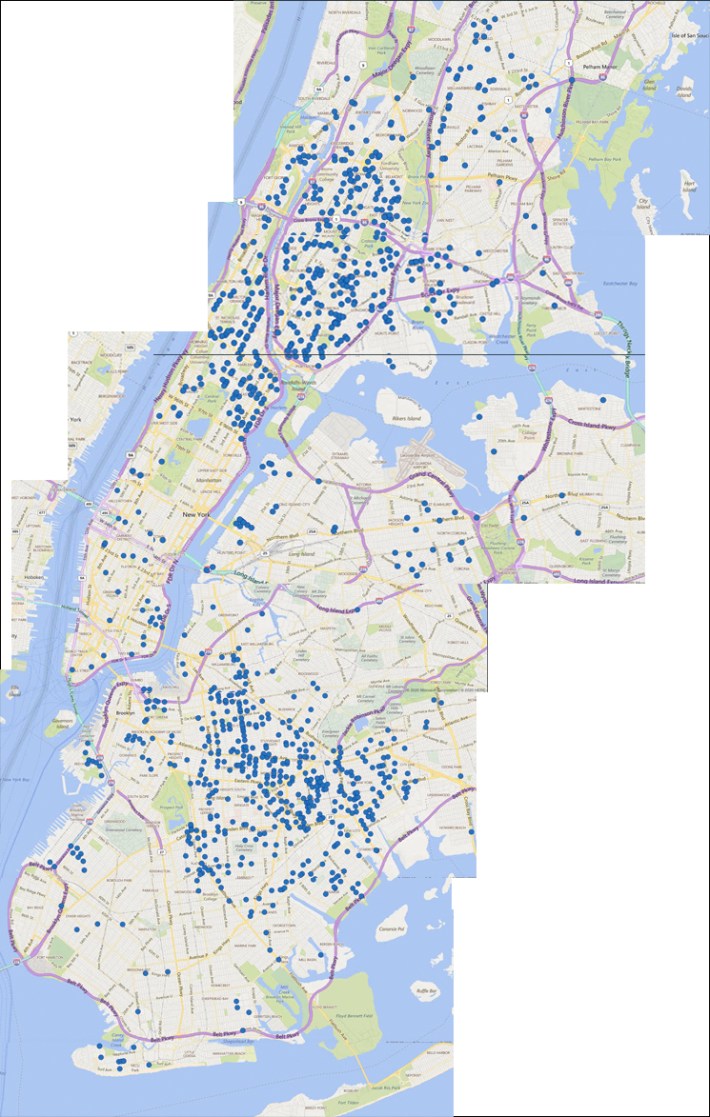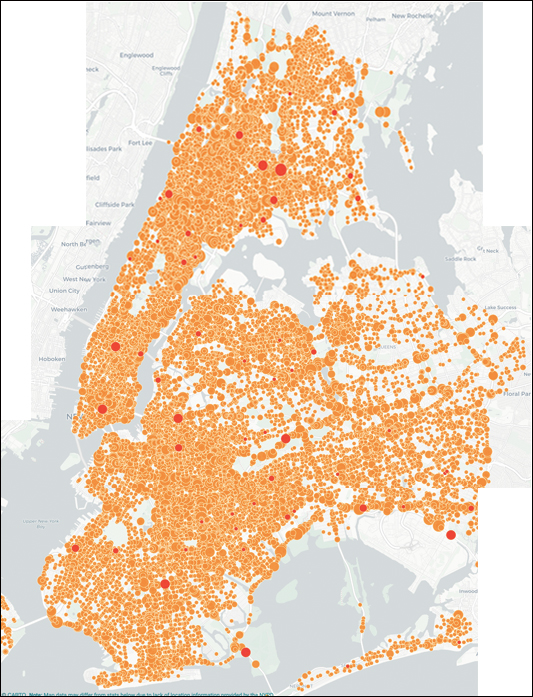
And these people want to be my mayor?
Other than COVID-19, there is a singular public health crisis in this city, with hundreds dying and tens of thousands of people wounded in the crossfire.
Guns? Well, sure, if you believe Maya Wiley, the supposed front-runner mayoral candidate whose big policy statement last week was a handout to the Daily News about her plans to combat the terrifying scourge of gun violence.
Wiley's policy rollout came a day before the NYPD released its latest statistics about the uptick in gun violence: So far this year, 1,730 people have been injured in 1,410 shooting incidents. That's roughly five shooting victims per day in roughly four shooting incidents per day.
The NYPD also put out another set of statistics covering the same period. So far this year, 40,321 people have been injured in 102,870 automobile collisions. That's roughly 121 injuries, and 308 injury-causing crashes, every single day.
Here are two maps that tell that story graphically. First, a composite map of the gun violence victims (each blue dot represents a victim):

Now, a composite map of the road violence victims (each orange dot represents a victim; a red dot represents a fatality):

In both maps, there is too much violence. But in the top map, the violence is spread out in a few neighborhoods. In the bottom map, the violence is everywhere, with the orange dots pretty much approximating the outline of the city, filling every major and most minor roadways. The only holes in the map are airports, parks, marshes and office parks. (The map of non-injury-causing crashes turns New York into just a big yellow blog.)
This is not to say that Wiley is wrong to address gun violence, which destroys lives and undermines communities.
But like virtually all the mayoral candidates, she is wrong to ignore the much-larger public health crisis in front of us. Each mayoral candidate so far has stated unequivocally that he or she will be a 180-degree turn from Mayor de Blasio, but in running from the mayor, it seems the candidates are also running from the singular achievement of the de Blasio administration: highlighting the damage that road violence does to the pursuit of a more equitable city.
But there's not a word on Wiley's website about the 230 people who will be killed or the 45,000 people who will be maimed this year on our streets. There's not a word about this public health crisis on Ray McGuire's website either. There's nothing from Kathryn Garcia, Loree Sutton, Dianne Morales, Scott Stringer, Eric Adams, Shaun Donovan, or even Carlos Menchaca (whose campaign launch video featured him on his bicycle). Zach Iscol mentions bicycles once, but only as a solution to congestion.
That doesn't mean the candidates won't address road violence at some point, but, right now, it's not a priority to any of them. Maybe they don't think there's a big policy paper to leak to the News or Times because, well, car crashes are just accidents — you can't prevent them, right?
Talking about redesigning streets isn't a high priority because it's not shiny — it's gritty (and a lot of work!) — with few ribbon-cuttings that don't get into the papers anyway.
And cracking down on reckless driving isn't sexy (nor a big vote-getter, given that more than one million New Yorkers own cars, and shaming them for endangering their neighbors has not traditionally been seen as good politics). But recklessly driving New Yorkers just happen to be the danger that stalks everyone, in every neighborhood, all the time.
Streetsblog has reached out to the candidates during this early part of the campaign and have gotten lackluster canned responses (except from Iscol) and plenty of no comments. For now, we know Wiley from the time she happily tweeted a picture of the parking placard on her dashboard (she declined to talk to us for this piece), and McGuire from his jogging through Times Square in his Spike Lee-narrated introduction to New York (he also declined to call us back).
Nothing is going to change if we elect someone whose view of the city is from 20,000 feet off the ground or from behind a windshield. Nothing is going to change if we elect someone who is not even aware that are roughly than 215,000 car crashes per year in New York City — or roughly 590 per day.
For now, the candidates are offering a macro view of urban government, which is, indeed, crucial if you're trying to get money out of Mitch McConnell, dealing with the Big Dog in Albany or setting general policies. But don't tell me you know how to reform the $1-billion Department of Transportation if you've never sat through a three-hour "visioning session" and heard a Queens car owner put the value of her parking space ahead of a kid's life (and then be told by the DOT rep, "Thanks for that helpful comment!"). Don't tell me you know how to improve road design if you haven't been to a single vigil for a dead kid or delivery worker (as Stringer and Menchaca have ... repeatedly) or, frankly, been close to being that dead kid or delivery worker. Don't tell me you want to reduce car ownership in this city then drive around to every campaign stop rather than taking a subway or bus (like Cynthia Nixon did during her failed run for governor).
People who run for high office like to talk about grabbing the horns of this big bull of a city and wrestling the beast to the ground. But that's not how you solve the public health crisis of road violence. You solve it redesigning every street, one at a time. You solve it by getting reckless drivers off the roads with a harm-reduction strategy that focuses on the worst drivers and car-reduction strategies for the rest of us. You solve it by not asking drivers what they'd like to see in their communities, but by building safer streets and redirecting tax money towards transit — and then looking car owners in the eyes and telling them that if they don't like it, they can move to a place where their cars are more welcome.
Otherwise, you're just driving past the problem.
Gersh Kuntzman is the editor of Streetsblog. He writes the Cycle of Rage column when he can contain his ire no longer. Prior columns are archived here.






